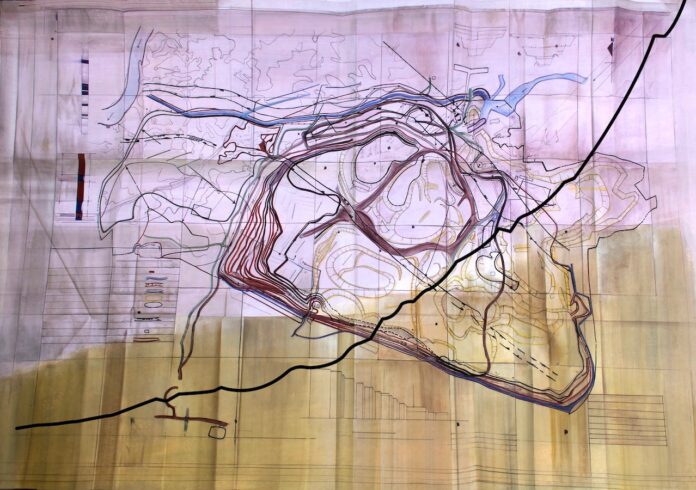DUBAI: For her first show in Dubai and the Arabian Peninsula, revered Indian artist Navjot Altaf will showcase a range of abstract work exploring the pressing issues of climate change, ecology and feminism, and their presence in our increasingly digital age.
Since the 1970s, Altaf’s practice has involved various media, including painting, photography, sculpture, installation, video, site-specific works and activism. Titled “Pattern,” her upcoming show will open at the Ishara Art Foundation in Alserkal Avenue on Sept. 14 and constitute, like its title, Altaf’s rich array of expression, as she raises pertinent issues relevant to the survival of our environment and humankind.
Altaf, born in 1949, and who currently works between Mumbai and Bastar, a district in Central India, has shown her work throughout India and South Asia as well as prominent international institutions, including London’s Tate Modern, National Museum of Modern and Contemporary Art in Seoul, and PAV Arte Vivente in Turin.
‘Seriousness of Issues.’ (Supplied)
“My work addresses how to deal with the contradictory and paradoxical times we live in,” the artist tells Arab News. “I look at one’s dreams, concerns and questions and how we can find hope.
“I am in solidarity with all those who imagine the world differently and want to organize it differently.”
Through her work Altaf foregrounds issues relating to anthropogenic environmental changes or climate change in which, she says, “the intersection of local, regional, and national politics is entangled with urgencies of development and the power of national and global capital as an obsession with growth for a society, not necessarily for all sectors in mind.”
Altaf has long looked at how she can use her work to help destitute and struggling communities in India. In 1997, for example, she relocated to Bastar, a district in Central India, where she co-founded DIAA (Dialogue Interactive Artists Association), an organization run by fellow creatives, alongside artists Rajkumar Korram, Shantibai, and Gessuram Viswakarma. Together they have worked with indigenous communities to find ways of creating sustainable means of livelihood, advocating justice, and bringing attention to the social and ecological crises in the region through the narratives in their art.
‘Pattern.’ (Supplied)
“Pattern” will include six bodies of work Altaf has made since 2014 and 2015, which is the year of the United Nations Climate Change Conference and the Paris Climate Accords. Works on view capture how Altaf uses her art in conjunction with other artists, activists and organizations to trace the connections between human exploitation and the impact of climate change.
For example, “How Perfect Perfection Can Be” (2016-2017) is a set of 24 abstract watercolors that pay tribute to what the artist calls “imaginative, and laboring minds and hands” to critique the celebration of urbanization and authoritarianism. Her intricate watercolors are based on the details found in glass buildings and other monoliths in New York but over which she superimposes line graphs relaying information on the impact of climate change.
Another work on view will be “Soul Breath Wind” (2015), a multi-channel video which evolved from Altaf’s research and contact with the local communities in the Northern Central part of Chhattisgarh in India. “They are fighting for justice against forces who are increasing the vulnerability of ecosystems that have impacted people’s lives, their culture and their contribution to the maintenance of the ecosystem for centuries as they don’t see themselves outside nature,” explains Altaf. “I see them as a community of (resistance). I am interested in learning from their lived knowledge systems as well as from scientific analysis.”
Altaf’s practice has involved various media, including painting, photography, sculpture, installation, video, site-specific works and activism. (Supplied)
Also shown will be 24 small sculptures titled “Patterns Which Connect” (2018) previously on display at PAV in Torino in 2019. The collection of 24 fossil-like sculptures shed light on the diverse natural ecosystem that is under threat due to urbanization and human intervention.
“It shows how aggressive human intervention in nature has been destroying biodiversity that comprises other organisms in the earth, including insects,” she said. “Together we form the web of life, but several insects are becoming extinct species. These fossils-like forms I have made reflect on what would happen if insects vanished from the planet.”
Curated by Sabih Ahmed, associate director and curator at Ishara Art Foundation, the exhibition presents Altaf’s rich multitude of media, and her exploration of socio-economic hardship inflicted by ecological crises.
‘Pattern.’ (Supplied)
“Climate-related issues are certainly posing problems for countries around the globe, including the Middle East, which is one of the most waters-stressed regions and in the coming years could threaten millions of lives and livelihoods,” added Altaf.
In “Seriousness of Issues,” she presents a graph of statistical information that track seven indices of ecological disasters she collected since 2011. The work is used in relation to her series “How Perfect Perfection Can Be” presenting the shortage of fresh water, air pollution, automobile emissions and climate change worldwide. “These changes to our ecology have affected every living being on (the) planet, no matter where we live.”

